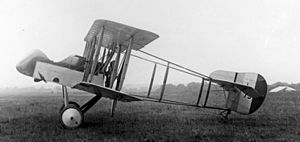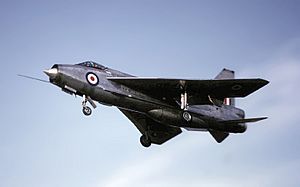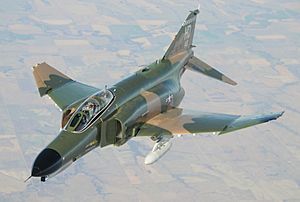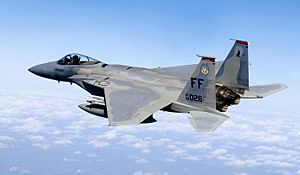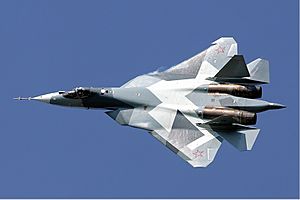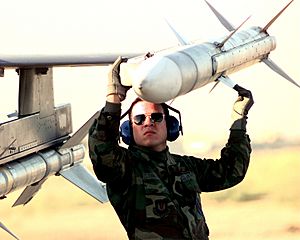Fighter aircraft facts for kids
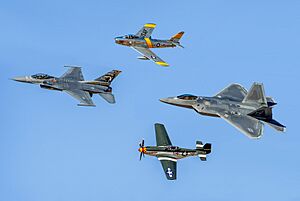
Fighter aircraft are special military aircraft built mainly for fighting other planes in the sky. Their main job in a war is to gain control of the sky over a battle area. When fighters control the sky, friendly bombers and attack aircraft can safely attack enemy targets on the ground. This also stops the enemy from doing the same.
Fighters need to be fast and able to turn quickly compared to the planes they are fighting. How well a country controls the sky depends on its pilots' skills, smart battle plans, and how many and how good its fighter planes are.
Many modern fighters can also attack targets on the ground. Some, like fighter-bombers, are designed for both jobs from the start. Other fighters are very specialized, like interceptors, which are built to stop enemy planes quickly.
Contents
- How Fighters Changed Over Time
- Rocket-Powered Fighters
- Jet-Powered Fighters
- Fighter Weapons
- See also
How Fighters Changed Over Time
Since World War I, controlling the sky has been super important for winning wars.
Early Fighters: World War I
Fighters were first developed during World War I. Their goal was to stop enemy planes and dirigibles from spying on battlefields. Early fighters were small and didn't have many weapons. Most were biplanes (planes with two sets of wings) made of wood and fabric. They could only fly about 100 miles per hour (160 km/h). A successful German biplane, the Albatross, was made with plywood, making it stronger and faster.
As controlling the sky became more important, all major countries built fighters. Between the wars, wood was slowly replaced by metal, making planes even stronger.
The first "fighters" were often two-seat planes with a machine gun and its operator. The French Voisin III was the first to shoot down another aircraft in 1914. At the start of World War I, most planes were unarmed and used for scouting. Pilots soon started carrying pistols or rifles, but these were hard to use while flying.
The big breakthrough was putting a machine gun that fired forward. This meant the pilot could aim the whole plane at the target. Early versions had metal plates on the propeller to deflect bullets. Soon, a special gear called a synchronization gear was invented. This gear timed the machine gun to fire *between* the spinning propeller blades. This invention, first used effectively by the Germans with the Fokker Eindecker, gave them a big advantage for a while.
Later, planes like the Albatros D.I and Sopwith Pup became common. Most were biplanes with one or two machine guns that fired through the propeller. Pilots like Oswald Boelcke and Max Immelmann developed smart ways to fly and fight in groups.
By 1918, German pilots started using parachutes, but Allied pilots did not. More than 50,000 airmen died during the war.
Fighters Between the World Wars
Fighter development slowed down after World War I, especially in the US and UK, because there wasn't much money for it. Countries like France, Italy, and Russia kept developing new planes, including metal monoplanes (planes with one set of wings).
Biplanes like the Gloster Gladiator and Fiat CR.42 Falco were still used even in the late 1930s because pilots liked how agile they were. Most fighters still had two machine guns in front of the pilot.
Engines became much more powerful. A typical fighter engine went from 180 horsepower in 1918 to 900 horsepower in 1936. The Spanish Civil War (1936-1939) was a testing ground for new German, Italian, and Soviet planes. The German Messerschmitt Bf 109 and Soviet Polikarpov I-16 were tested in real combat. The lessons learned helped Germany improve its fighters for World War II.
A new flying formation called the "finger-four" was developed by German pilot Werner Mölders. This formation allowed pilots to see more around them and work together better. It became a standard tactic in World War II.
Fighters in World War II

World War II saw more fighter combat than ever before. Fighters were crucial for gaining control of the sky and stopping bombers. They also helped ground troops and spied on the enemy.
Fighter designs were different in various countries. Japan and Italy preferred light, easy-to-turn planes like the Mitsubishi A6M Zero. Other countries like the UK, Germany, and the US focused on speed and firepower. While light planes were good at dogfighting, heavier planes were better at stopping bombers or attacking ground targets.
In Europe, German fighters like the Messerschmitt Bf 109 were very strong early in the war. But during the Battle of Britain, British Hurricanes and Spitfires fought them equally. Britain's radar system also helped them win the battle. On the Eastern Front, Soviet fighters struggled at first against the Germans, but later improved with planes like the Yakovlev Yak-9 and Lavochkin La-5.
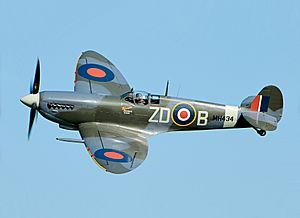
On the Western Front, Allied fighters mainly protected bombers attacking Germany. The arrival of long-range fighters like the North American P-51 Mustang allowed American bombers to fly deep into Germany with protection. By 1944, the Allies had almost complete control of the sky over Western Europe. This helped them win the war.
In the Pacific, Japanese fighters like the Zero were very successful at first. But by mid-1942, Allied planes like the Grumman F6F Hellcat and Vought F4U Corsair arrived. These planes were tougher and had more firepower. The Allies also developed new tactics. By 1944, Allied fighters controlled the skies in the Pacific.
New Technologies in World War II
Fighter technology changed very fast during World War II. Piston engines became much more powerful, going from about 1,000 horsepower to over 2,000 horsepower. However, propeller planes were reaching their speed limits.
German jet and rocket-powered fighters appeared in 1944, but too late to change the war. The Allies' only jet fighter, the Gloster Meteor, also entered service that year.
Planes were built with stronger, lighter materials. Wings were designed for better high-speed flight. Weapons also improved. Rifle-caliber machine guns were replaced or joined by cannons, which fired explosive shells that could destroy planes with just a few hits. Many fighters also started carrying bombs or rockets to attack ground targets, becoming fighter-bombers.

Radar was first used on fighters during World War II, mainly on larger night fighters to find enemy bombers in the dark. The Northrop P-61 Black Widow was the only fighter designed from the start with radar.
A German invention called Schräge Musik involved upward-firing cannons in night fighters. This allowed them to attack bombers from below, where they were vulnerable.
After World War II: The Jet Age Begins
After World War II, piston-engine fighters were quickly replaced by jets. The Lavochkin La-9 was one of the last advanced piston-engine fighters, but the Korean War showed that jets were the future.
Rocket-Powered Fighters
The first rocket-powered aircraft flew in 1928. The only rocket plane made in large numbers was the German Messerschmitt Me 163B Komet in 1944. It was designed for quick, high-speed attacks.
In the 1950s, the British tried to combine rocket and jet engines in planes like the Saunders-Roe SR.53. The rocket gave them speed and height for intercepting bombers, while the jet helped with fuel economy. However, jet engines improved so fast that these mixed-power designs became unnecessary.
Jet-Powered Fighters

Experts often group jet fighters into "generations" to show how they've changed. These generations describe different stages of design, performance, and technology.
First-Generation Jet Fighters (1940s–1950s)
These were the first jet fighters, appearing late in World War II and soon after. They looked a lot like propeller planes and often had straight wings. Guns were still their main weapon. Jets were developed because propeller planes couldn't go much faster.
The German Messerschmitt Me 262A was the first jet fighter to be used in combat in 1944. It was much faster than propeller planes. Britain's Gloster Meteor also entered service around the same time. These early jets showed that propeller planes were becoming old-fashioned.
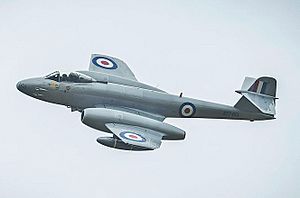
Early jets had some problems. Their engines didn't last long and were slow to respond. But new features like ejection seats (to help pilots escape) and air brakes (to slow down quickly) became common.
In the Korean War, American F-80 Shooting Stars faced the Soviet Mikoyan-Gurevich MiG-15. The MiG-15 had swept wings, allowing it to fly closer to the speed of sound. The Americans quickly brought in their own swept-wing fighter, the North American F-86 Sabre, to fight the MiGs. These two planes were very similar, and battles between them were intense.
Navies also started using jets, even though they needed special catapults to launch from ships. Early air-to-air missiles (AAMs) like the AIM-9 Sidewinder (heat-seeking) and AIM-7 Sparrow (radar-guided) were also introduced on naval fighters.
Second-Generation Jet Fighters (1950s–1960s)
New ideas in how planes fly, better engines, and stronger materials (like aluminum) led to second-generation fighters. Designers tried out new wing shapes like swept wings and delta wings. These were the first planes that could fly faster than the speed of sound (supersonic) in level flight.
Fighters also got smaller, more effective radars. This allowed them to find enemy planes beyond what the pilot could see. Air-to-air missiles started to become the main weapon, replacing guns. Early heat-seeking missiles could only track planes from behind, and radar-guided missiles were not very reliable at first.
During this time, fighters became more specialized. Some were interceptors, designed to quickly stop enemy bombers, like the English Electric Lightning. Others were fighter-bombers, able to switch between air combat and ground attack, like the Republic F-105 Thunderchief. Dogfighting (close-up air combat) was thought to be less important.
Third-Generation Jet Fighters (1960s–1970s)
Third-generation fighters improved on the ideas from the second generation. But they also brought back the focus on being able to turn quickly and attack ground targets. New parts like canards (small front wings) and slats (parts on the wing edge) helped planes maneuver better.
Air combat lessons from the Vietnam War showed that close-up dogfights were still happening. This led to better air-to-air missiles and radar systems. Guns remained standard, even though some early F-4 Phantoms didn't have them at first. The US Navy even started the famous ""TOPGUN" school to teach pilots advanced air combat skills.
Ground attack also improved with guided missiles and special systems for flying low to avoid radar. Laser-guided bombs became common for precise attacks. New automatic cannons, like the M61 Vulcan, allowed planes to carry powerful multi-barrel guns.
The McDonnell Douglas F-4 Phantom II was designed as an all-weather interceptor but became a very versatile plane. It could attack ground targets and was agile enough to win air battles. The Phantom was used by the US Navy, Air Force, and Marine Corps and achieved many aerial victories in Vietnam.
Fourth-Generation Jet Fighters (1970s–2000s)
Fourth-generation fighters continued to be multi-role planes with very advanced electronics and weapons. Their design was heavily influenced by the "Energy-Maneuverability" theory, which focused on how well a plane could change its speed, altitude, and direction quickly.
This led to planes like the General Dynamics F-16 Fighting Falcon, which was small, light, and had a large wing for better turning. The F-16 was also one of the first planes to use "fly-by-wire" controls, where computers help the pilot fly the plane. This made the F-16 incredibly agile.
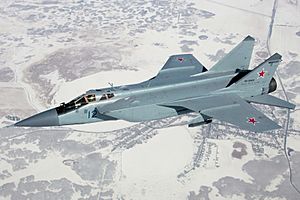
Other new technologies included pulse-Doppler radar (which could see planes below it), head-up displays (HUDs) that showed information on the pilot's visor, and "hands on throttle-and-stick" (HOTAS) controls. Designers also started using composite materials to make planes lighter.
Long-range radar-guided missiles like the AIM-54 Phoenix were introduced. Even with these powerful missiles, internal guns remained standard. Maintenance also became easier, meaning planes spent less time on the ground and more time flying.
Most fourth-generation fighters, like the McDonnell Douglas F/A-18 Hornet and Dassault Mirage 2000, were designed as true multi-role warplanes from the start. This meant they could easily switch between air and ground missions.
The idea of "stealth" also appeared, using special materials and shapes to make planes harder for enemy radar to detect. The first stealth aircraft were the Lockheed F-117 Nighthawk (an attack plane) and the Northrop Grumman B-2 Spirit (a bomber).
4.5-Generation Fighters (1990s–2000s)

After the Cold War ended, many countries cut military spending. This slowed down the development of "fifth-generation" fighters. However, it allowed designers to use new advances in computers and electronics to improve existing fourth-generation designs. These improved planes are called "Generation 4.5" fighters.
They feature advanced digital electronics, some radar-reducing stealth features, and highly integrated systems. They are designed to work in a "network-centric" battlefield, meaning they share information with other planes and ground stations. Key new weapons include better beyond-visual-range missiles and GPS-guided bombs.
Many 4.5-generation fighters, like the Eurofighter Typhoon, Dassault Rafale, and Saab JAS 39 Gripen, use a lot of carbon-fiber composites to reduce weight. Others are upgraded versions of older fourth-generation planes, like the Boeing F/A-18E/F Super Hornet and Su-35S. These planes are still being produced and used today.
Fifth-Generation Jet Fighters (2000s–2020s)

Fifth-generation fighters are the most advanced today. They are designed from the start to be "network-centric" and have very low radar and heat signatures (stealth). They use advanced materials and special shapes to be almost invisible to radar. Their main weapons are carried inside the plane to keep their stealth.
They have advanced AESA radars that can do many jobs, and infra-red search and track (IRST) sensors that constantly track targets around the plane. All these sensors and electronics are highly integrated to give the pilot a complete picture of the battle, making their job easier. This allows them to "first-look, first-shot, first-kill."
The Lockheed Martin/Boeing F-22 Raptor was the first fifth-generation fighter, entering service in 2005. It is very expensive. To share costs, the Joint Strike Fighter (JSF) program involves many countries working together to build the Lockheed Martin F-35 Lightning II. The F-35 comes in three versions: for regular runways, for short takeoffs and vertical landings, and for aircraft carriers.
Other countries are also developing fifth-generation fighters. China has the Chengdu J-20 and Shenyang J-35. Russia has the Sukhoi Su-57, which entered service in 2020 and has been used in the Russo-Ukrainian War. India is developing the Advanced Medium Combat Aircraft (AMCA).
Sixth-Generation Jet Fighters (2020s–Present)
Several countries, including France, Germany, China, Japan, Russia, Italy, the UK, and the US, are now working on sixth-generation aircraft programs.
France and Germany are developing a joint sixth-generation fighter to replace their current planes by 2035. The UK, Japan, and Italy are working together on "Team Tempest" for a fighter expected in 2035.
The US Navy plans to replace its F/A-18E/F Super Hornets starting in 2025 with a new air superiority fighter. The US Air Force is also looking for a "Next Generation Tactical Aircraft" for the 2030-2050 period. These future fighters will likely be even more advanced, possibly using artificial intelligence and drone technology.
Fighter Weapons
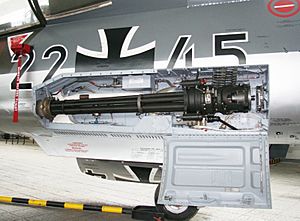
Fighters have always used guns for air-to-air combat, and they are still important today. The power of these guns has grown a lot. In World War I, two rifle-caliber machine guns were common. In World War II, planes had more machine guns or cannons that fired explosive shells.
Modern fighters use powerful 20–30 mm revolver cannons and rotary cannons, like the M61 Vulcan. These guns fire much heavier bullets at higher speeds. They also have radar and computer sights to help pilots aim. While guns are effective and cheap, their range is limited to about 1,000 meters.
To overcome the limits of guns, air-to-air missiles were developed. There are two main types: heat-seeking (infrared homing) and radar-guided. Heat-seeking missiles are smaller and cheaper, with ranges of about 10 to 35 km. They track the heat coming from an enemy plane. The AIM-9 Sidewinder is a very successful heat-seeking missile. Newer versions can track from any angle.
Radar-guided missiles are heavier and more expensive but have a longer range. Early radar missiles were not very reliable. In the past, the firing plane had to keep its radar locked on the target, which made it vulnerable. More advanced "active radar homing" missiles, like the AIM-120 AMRAAM, guide themselves to the target, freeing the firing plane to maneuver. The AIM-120D has a range of over 160 km at high altitude.
While early missiles had low success rates, they have improved a lot. In the 1991 Gulf War, radar-guided missiles were much more effective. Modern missiles allow fighter pilots to avoid risky close-range dogfights. They are also "force multipliers," meaning they make a fighter force much more effective.
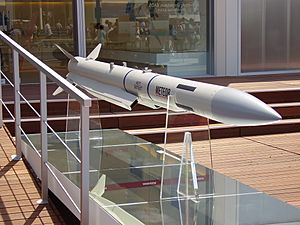
See also
 In Spanish: Avión de caza para niños
In Spanish: Avión de caza para niños
- List of fighter aircraft
- List of United States fighter aircraft
- Warbird


